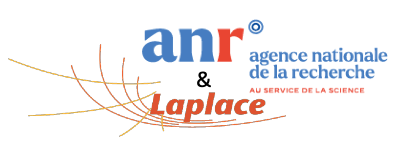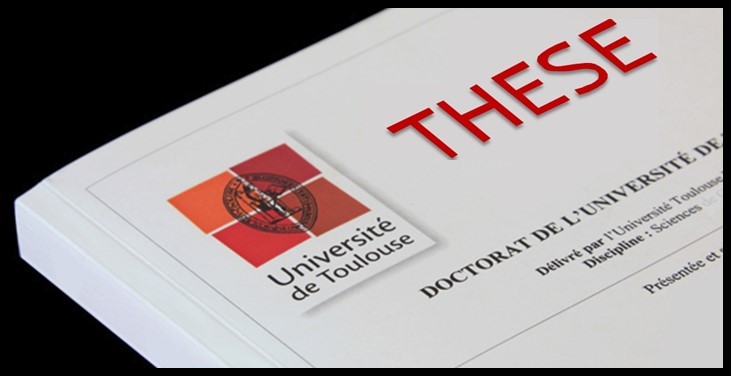
Soutenance de thèse – Baptiste Robbiani – Mardi 16 décembre 2025 à 09h45 – amphi Concorde U4 UT
Baptiste Robbiani soutiendra sa thèse le mardi 16 décembre 2025 à 09h45 – amphi Concorde U4 à l’UT, sur le sujet : « Analyse de
Head of group :
Laurent BOUDOU (Pr UPS)
Scientific animation :
Séverine LE ROY (DR CNRS)
OBJECTIVES of the team SOLID DIELECTRICS AND RELIABILITY – DSF :
The team’s activities primarily concern the reliability of isolated systems. The goal is to understand the mechanisms of charge generation and transport in insulators, as well as to identify the processes leading to aging and failure of materials, taking into account the functional constraints encountered in the devices. To this end, original characterization techniques are implemented, associated to numerical simulations of transport phenomena, in order to address specific issues in fields such as aeronautics, space, transport and energy storage. The group’s activities and fields of application are presented here.

The activities we carry out contribute to:
Key-words:
The team is organized around two research pillars: INSTRUMENTATION AND EXPERIMENTAL EXPERTISE, and PHYSICS AND MODELLING. These two pillars address issues related to the following application areas, in particular:
– Materials for Electrical engineering
– Charging environment
– Nanostructured materials and interfaces
Objectives :
The research carried out in this axis concerns, on the one hand, the study and mathematical modeling of the physicochemical phenomena involved in dielectric materials subjected to different constraints, and, on the other hand, the development and analysis of charge transport models using numerical tools such as the finite volume method, optimization algorithms and sensitivity analysis. This research, coupled with the analysis of experimental data from innovative characterization techniques implemented in the team, aims to better understand the charge generation and transport mechanisms in insulators and to identify the processes leading to aging.
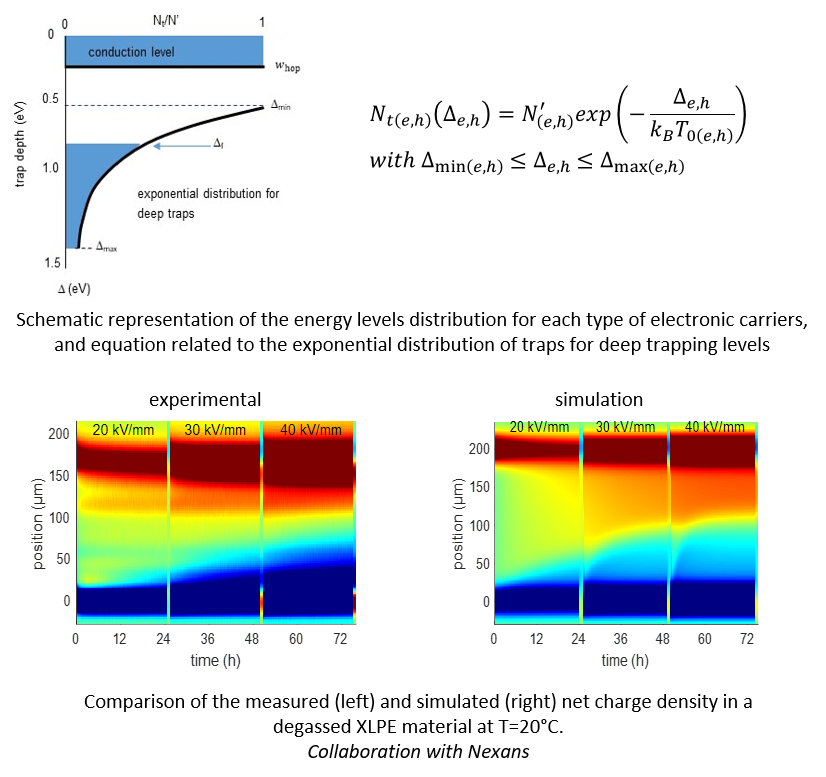
New charge transport model:
Charge transport models (i.e. hydrodynamic/fluid/mesoscopic models) have been developed since two decades and allow predicting the charge transport dynamic in insulating polymers under coupled constraints (thermic, electricl, radiation…).
One of the challenge remains to better describe the energy levels located within the band gap, known to act either as conduction sites, or as trapping sites for electronic carriers.
A new charge transport model has been developed, which describes the distribution of traps in a realisitc way, with one unique energy level for mobile carriers, and an exponential trap distribution for trapped carriers. This new model allows predicting the space charge and the current behaviour in a degassed crosslinked polyethylene (XLPE).
Modelling ion generation and transport:
In complex polymers such as crosslinked polyethylene (XLPE) ions are present and take part to charge transport and accumulation.
A new charge transport model has been recently developped, which accounts for ions transport, and generation either via dissociation of species, generating a positive and a negative ion, or via ionization, giving birth to a positive ion and an electron. These ionizable/dissociable species AB could for example be crosslinking by-product such as cumyl-alcohol, or anti-ocydants.
This new charge transport model accounts for electronic charges as well as ionic ones, and allow predicting heterocharge accumulation.

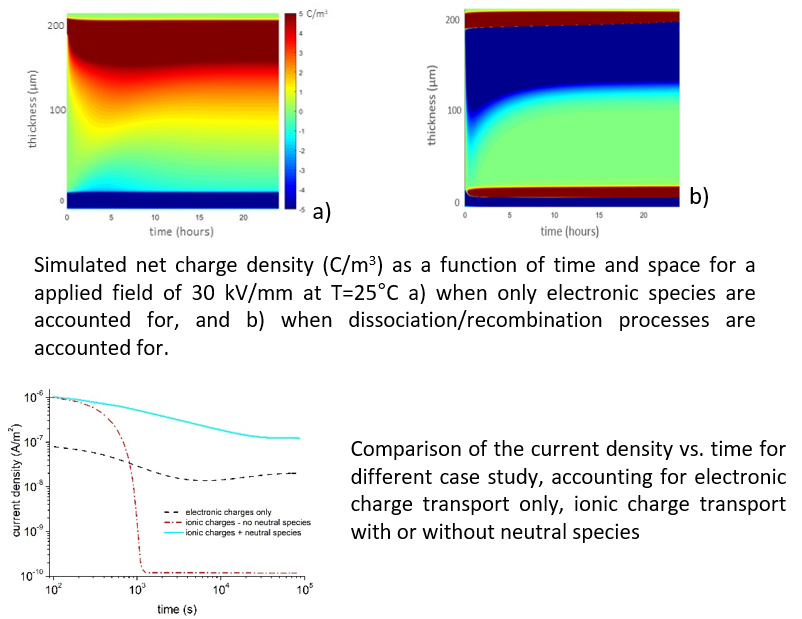
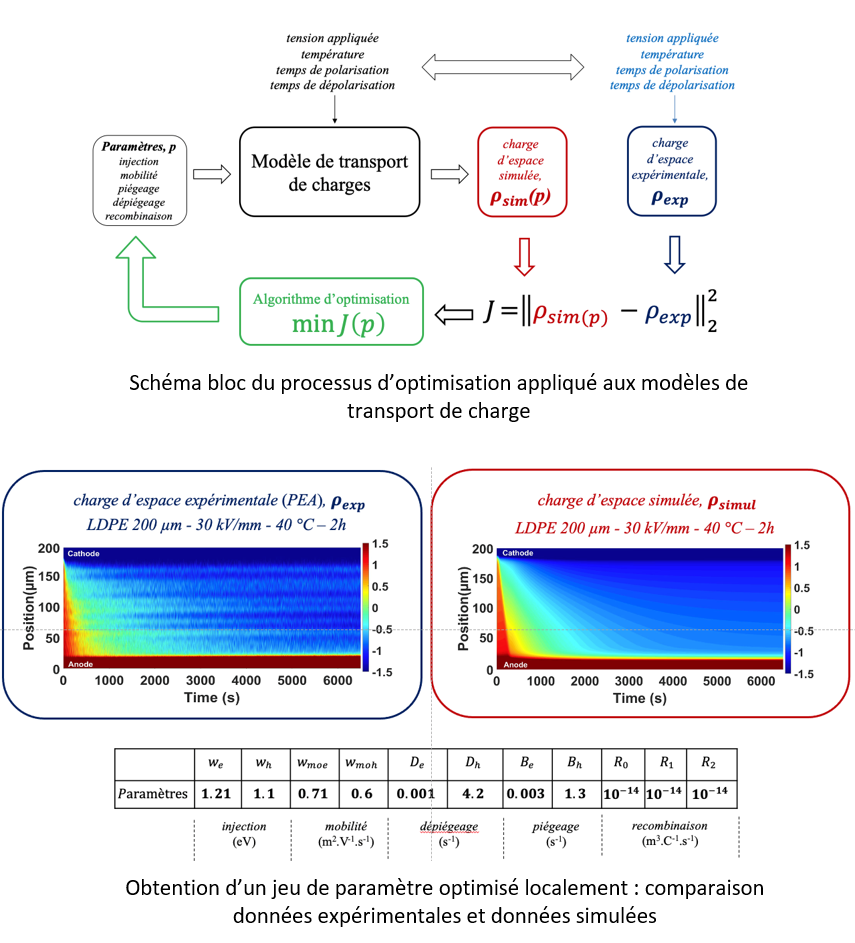
Optimization:
The problem concerns the parameterization of charge transport models developed by the team. The common link between these different models have in common is that they take into account numerous parameters (injection, mobility, trapping or untrapping coefficients, etc.) which cannot be predicted, observed or estimated from independent experiments.
Over the last few years, the DSF team has developed an optimization approach, in the form of a function to be minimized, allowing us to estimate the parameters influencing the charge transport processes. The aim is to use optimization tools to adjust parameters in such a way as to establish an optimal and systematic correlation between simulated and experimental data. Initial results obtained using constrained optimization show the merits of this approach, even if obtaining a single set of parameters remains a key objective for our team.
The aim is to have a reliable, robust optimization tool that gives a good prediction of the parameters as a function of the chosen physical phenomena, whatever the experimental study conditions.
Sensitivity analysis:
Optimization of the parameters used in the charge transport models can be a complex process, due in part to (i) the high non-linearity of the function describing charge transport, (ii) the large disparity in scale of the parameters sought, which can make it difficult for optimization methods to converge, and (iii) the computation time of this function, making it virtually impossible to adopt a stochastic approach based on evaluating the model at a large number of points.
To overcome these scientific challenges, our research focused on calculating various sensitivity indices using the Sobol technique, so as to be able to rank parameters according to their influence on charge transport. This essential step will enable us to make the best possible choice of input data, and to target the experiments to be carried out so that the cost function to be minimized possesses certain properties that facilitate optimization.
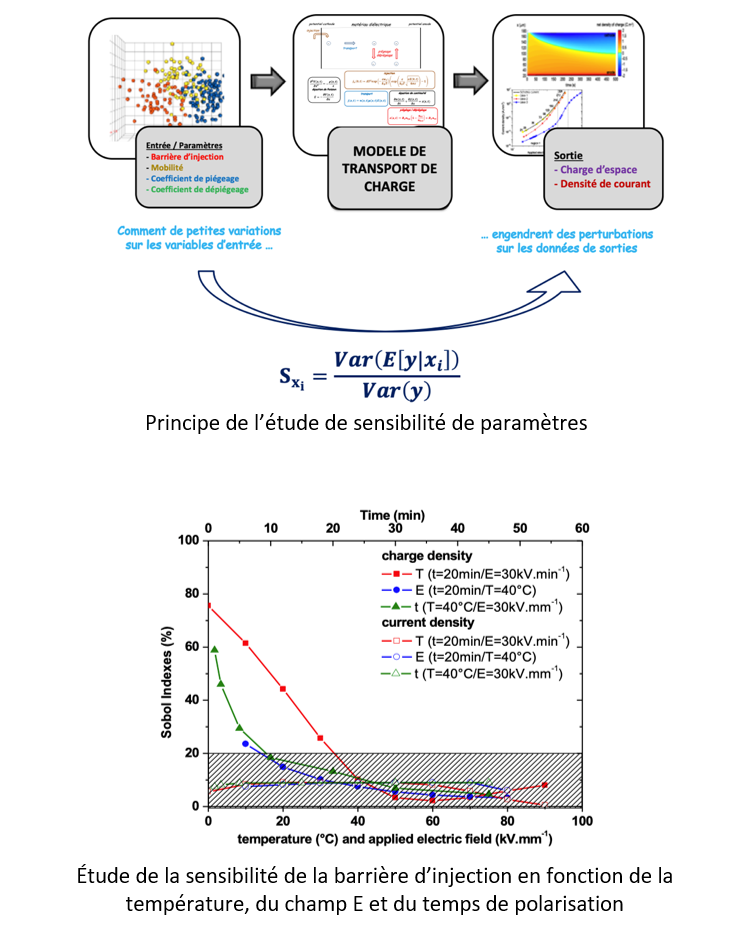
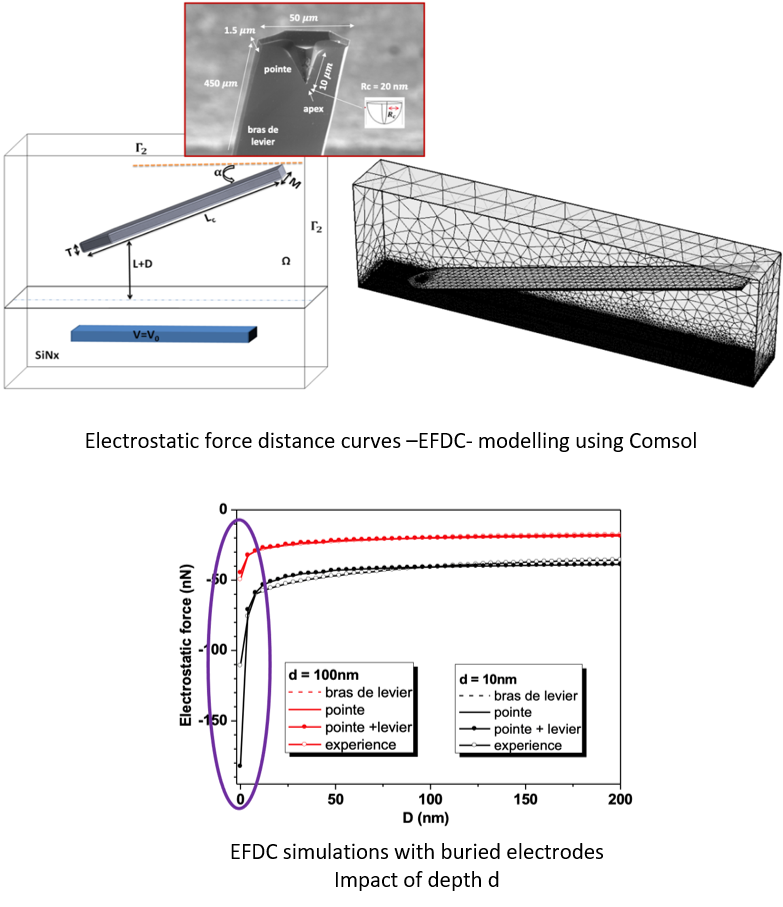
Inverse method applied to AFM:
This work addresses the problem of electrostatic charging of dielectric materials at nanometric scales. The experimental device chosen to characterize this type of material is Atomic Force Microscopy (AFM), which measures the electrostatic forces induced between the probe tip and the surface of a material. The aim is twofold:
– to analyze the metrological characteristics of the AFM probe in relation to its geometrical properties when used to measure electrostatic forces, by developing a multi-dimensional electrostatic model using a commercial software
– to generalize this model to the case of forces generated by charges implanted in the dielectric at different depths and spatial extensions. This is an inverse problem to be solved in order to recover, from experimental measurements (being in this case the electrostatic forces created by the charges), the space charge distribution.
Objectives :
Develop, characterize and optimize innovative characterization techniques for electrical insulating materials. These original techniques developed within the team allow measuring the space charge distribution, from sub-micrometric scale (some hundreds of nanometers) to macroscopic scale (some millimeters); the current (conduction, photocurrent, thermo-stimulated currents); the luminescence (cathodoluminescence, chemiluminescence or electroluminescence).
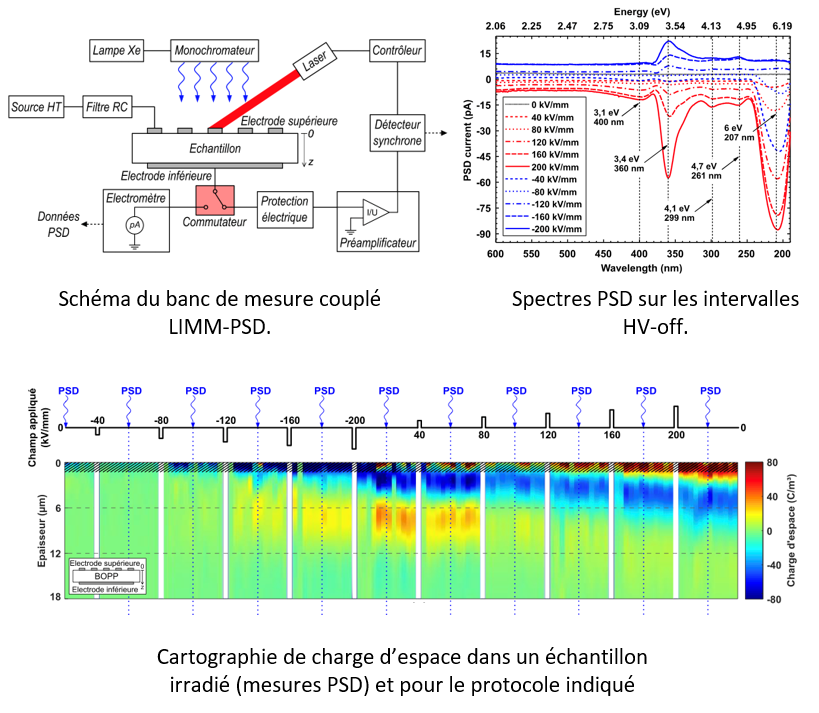
Coupling space charge and photo-stimulated discharge measurements:
We have developed and validated an experimental system that combines space charge measurements using the LIMM (Laser Intensity Modulated Method) with current acquisitions under optical excitation using the PSD (Photo-Stimulated Discharge) technique. The aim of this set-up is to study the relationship between space charge (spatial location, density and time evolution) and the energies associated with photocurrent (depth and energy distribution of traps) in order to improve our understanding of charge trapping and detrapping mechanisms in polymer insulators.
The originality of this work lies in the use of a switch to couple LIMM and PSD methods for consecutive tests. This configuration allows controlled switching between each measurement circuit without having to manipulate the sample, test cell or wiring connections, thus eliminating disruptive effects.
Development of the space charge measurement using the Pulsed Electro-Acoustic (PEA) method:
The PEA method uses an electric field pulse of very short duration (typically 5 to 10 ns) which, when applied to the charges present in the material and to the image and capacitive charges on the electrodes generates an acoustic wave. This wave propagates through the material and is detected by a piezoelectric sensor. The electrical signal from the sensor is then measured and analyzed to determine the charge density.
During propagation, the acoustic wave is attenuated, dispersed and reflected at interfaces. We have therefore developed a model of the PEA measurement cell using electroacoustic analogy, enabling us to simulate the behaviour of the cell and establish a transfer function that takes these phenomena into account.
This approach ensures that the electrostatic equilibrium is respected, guaranteeing a zero field outside the sample, which would not be guaranteed without taking into account the attenuation, dispersion and reflection of the waves.
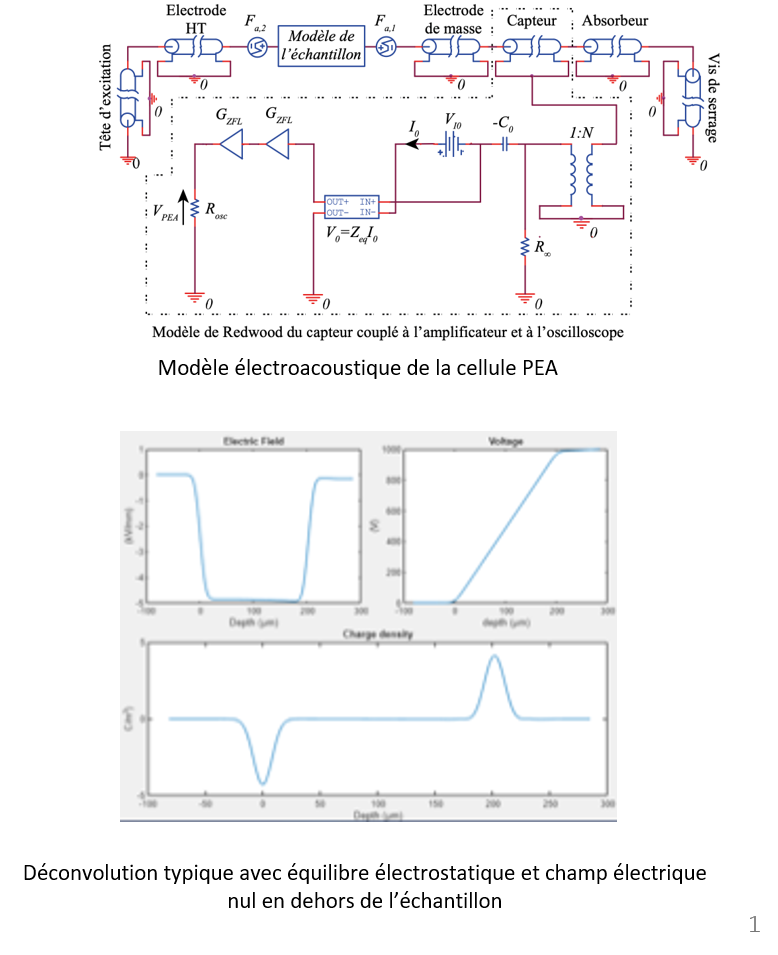
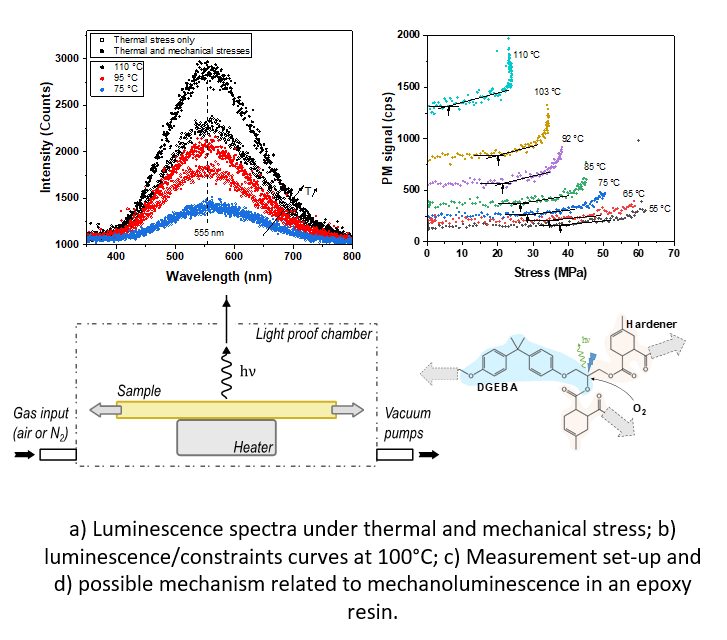
Mechano-luminescence in epoxy resins :
The goal is to study the coupled electrical-mechanical effects of insulator ageing, we are investigating the mechanoluminescence of undoped polymers. Very promising initial results have been obtained on epoxy resins: a luminescence signal is indeed detected under mechanical deformation. For the studied resins, these effects are produced above room temperature, and require oxygen in the ambient medium. Light emission spectra were recorded, similar to those obtained under purely thermal stress. Bond breaks are thoufht to occur at the network’s cross-linking nodes, and the luminescence is thought to come from the oxidation mechanisms following these bond breaks. This work paves the way for live visualization of damage, and will be pursued by combining electrical and mechanical stresses.Trap spectroscopy using thermo-stimulated depolarization currents :
In addition to photostimulated discharges, other methods for probing traps include charge recombination luminescence, performed by precharging the material with a homogeneous discharge, charge decay kinetics analysis and thermostimulated currents. The latter method has recently been reactivated with the analysis of a series of epoxy matrix composites. While the method is sensitive and, in principle, can rapidly scan the full spectrum of trap depths, the analysis requires strong assumptions, such as a discrete trap energy distribution and detrapping of charges with no retrapping, which are not necessarily verified. Also, as with other ‘electrical’ methods, it is necessary to distinguish between dipolar polarization and space charge effects.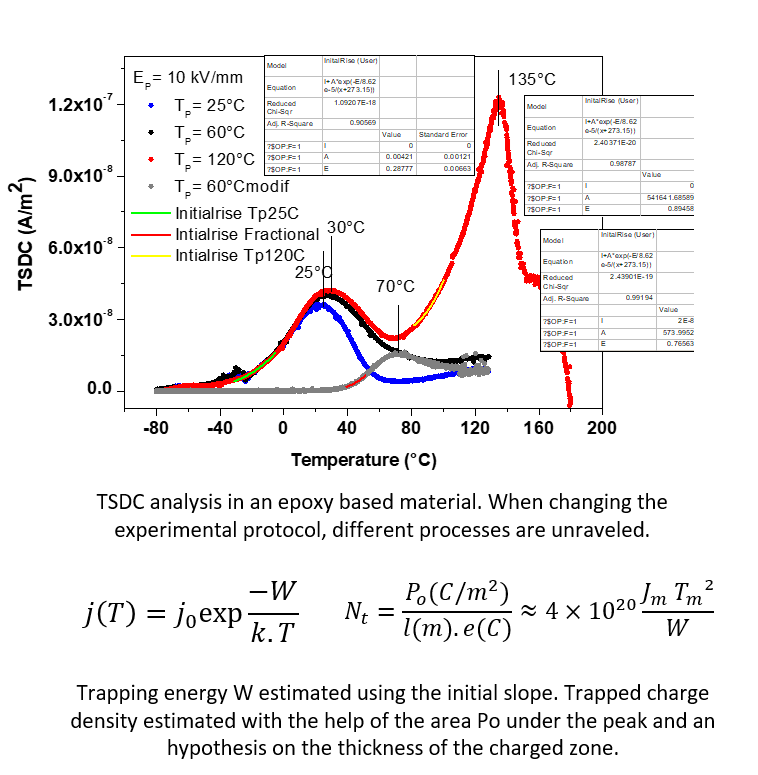
Overview and objectives:
Characterising the behaviour of electrical engineering insulators is one of the historical activities of the Laboratory and the DSF group.
The team’s current research focuses partly on the ageing phenomena of materials under thermoelectric stress and partly on loading and transport phenomena in insulators. The latter aspect supports the modelling activities and is seconded in particular by applications in the field of high-voltage direct current (HVDC) energy transmissions.
In both cases, there is a strong experimental component, using methods mostly developed within the group. The materials studied come from partnerships or collaborations and are in various forms, from films ten µm thick to plates and cables with several mm of insulation.
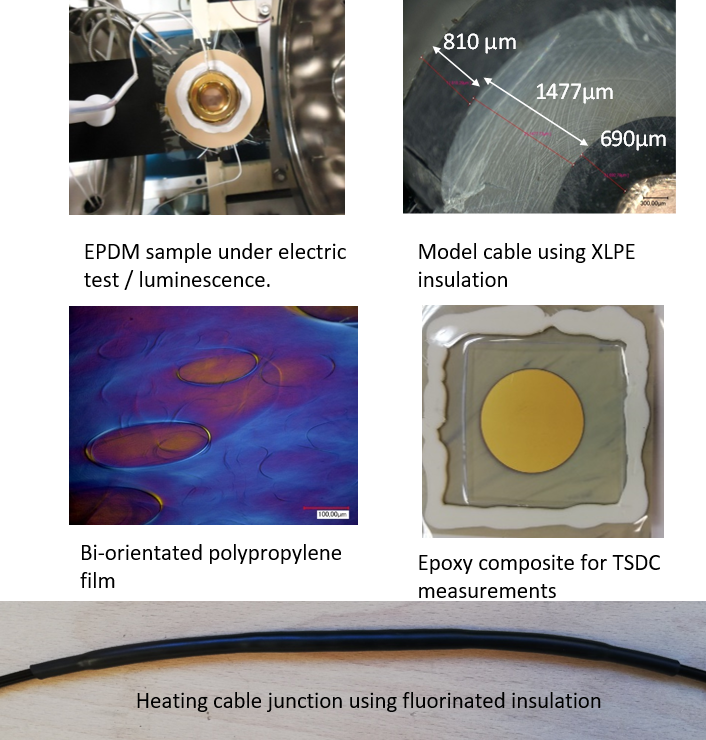
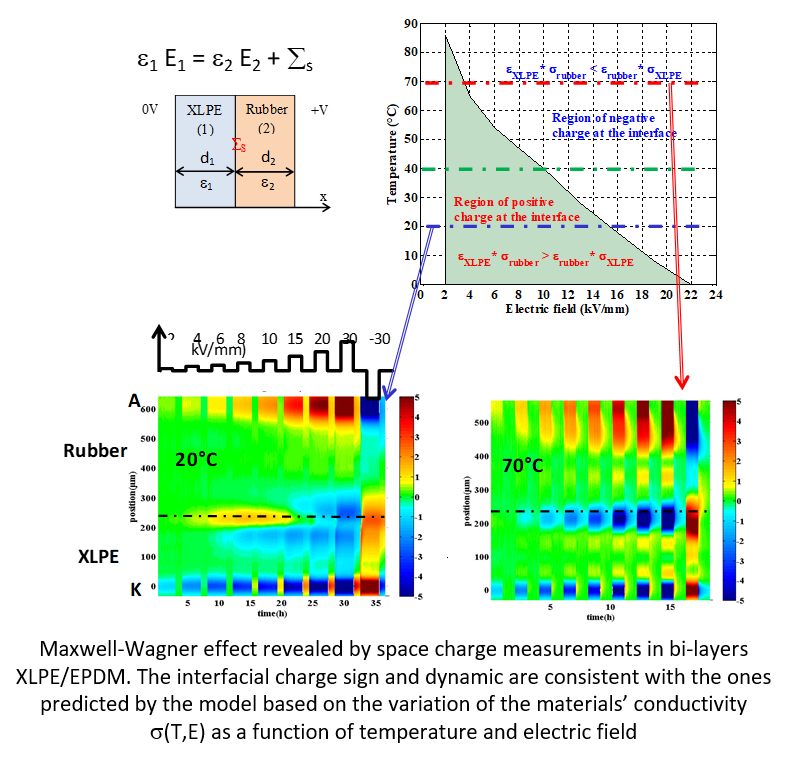
Materials under HVDC constraints:
The project is being developed in a context where HVDC stress links are developing rapidly, in line with the integration of renewable energy sources and the need to reinforce and interconnect networks. The construction of buried or submarine cable links poses the problem of insulation resistance under combined electrical and thermal stress, with field distributions that are difficult to anticipate and variable over time.
In this context, field distribution simulations are carried out using Finite Element Method (FEM) models (see Modelling section), fed by a set of field- and temperature-dependent conductivity characterizations as inputs to the models, and by space charge measurements on cables or flat samples as output verification. Multi-layer dielectrics and the resulting phenomena at interfaces are critical points that are also studied.
Field grading in HVDC cable junctions:
Using phenomenological conductivity models σ(E,T), it is possible to predict the electric field distribution at any point and at any time under unsteady thermal and electrical conditions.
Various aspects are being explored for grading the field in 200 kV cable junctions:
– Different connection materials;
– Action on the geometry (bending radius)
– Insertion of a layer of conductivity-modulated material.
In the future, we would like to optimize the materials properties or work on the geometries to modulate the field peaks. Another objective is to carry out 2D measurements of space charge and field distributions.
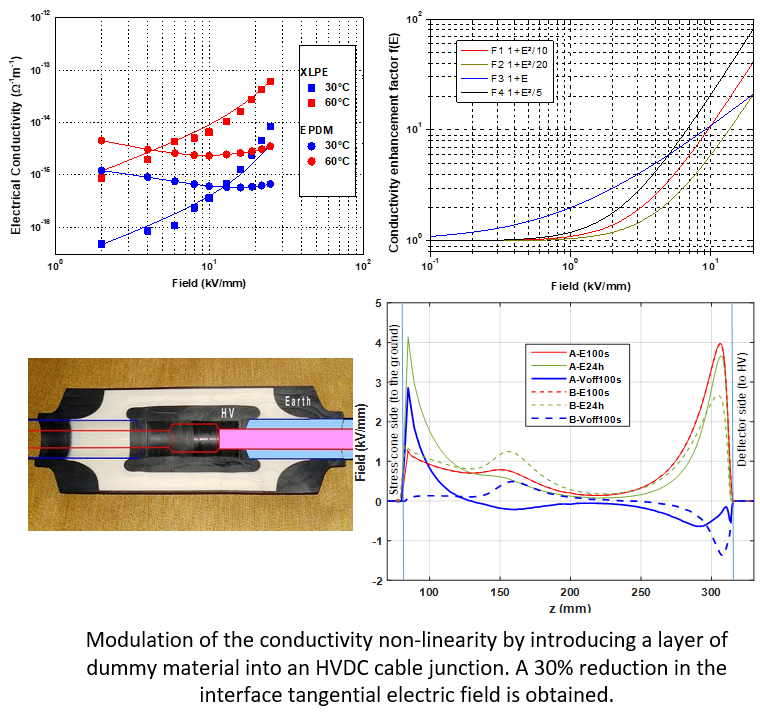
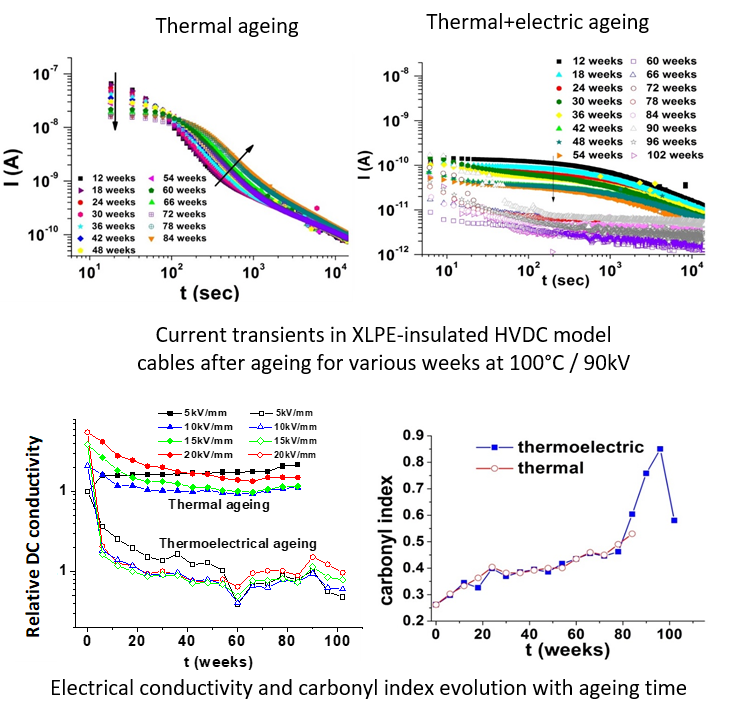
Thermoelectric ageing of HVDC model cables:
Criteria for evaluating materials with respect to their space charge behaviour are proposed and strategies for limiting charge accumulation phenomena are sought.
Ageing under DC stress involving short-circuiting and polarity reversals is also studied on model cables, by simultaneously carrying out space charge measurements under stresses of up to +/- 100kVdc. These data are compared with conductivity data and characterisations by conventional means (FTIR, TGA, DMTA).
During this project, a very significant decrease of the materials conductivity was obtained over almost 2 years of ageing, by combining thermal and electrical stresses. These results were not anticipated .
HVDC for aeronautic applications:
Energy transmission under DC stress is also increasingly interesting in the aeronautical industry, in response to issues of compactness. The issues are related to possible new forms of insulation failure under combined stress (depressurisation, high temperature, thermal gradients, etc.).
The approaches developed above can be transposed to various situations where continuous stresses are applied, although there are major differences in cable technologies such as the absence of a semiconductor screen, the presence of dielectric multilayers, voids, high-temperature excursions, which make measurements more delicate.
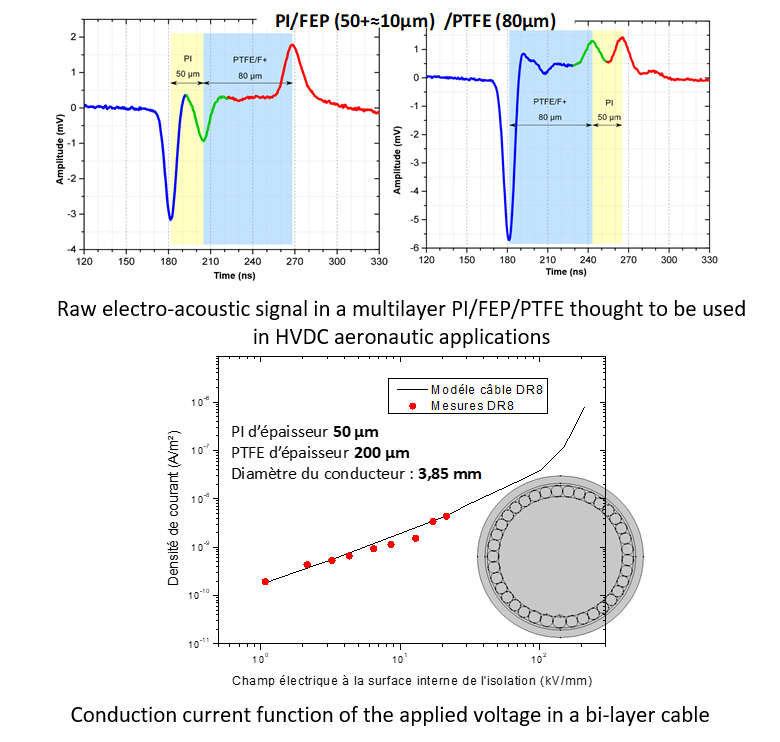
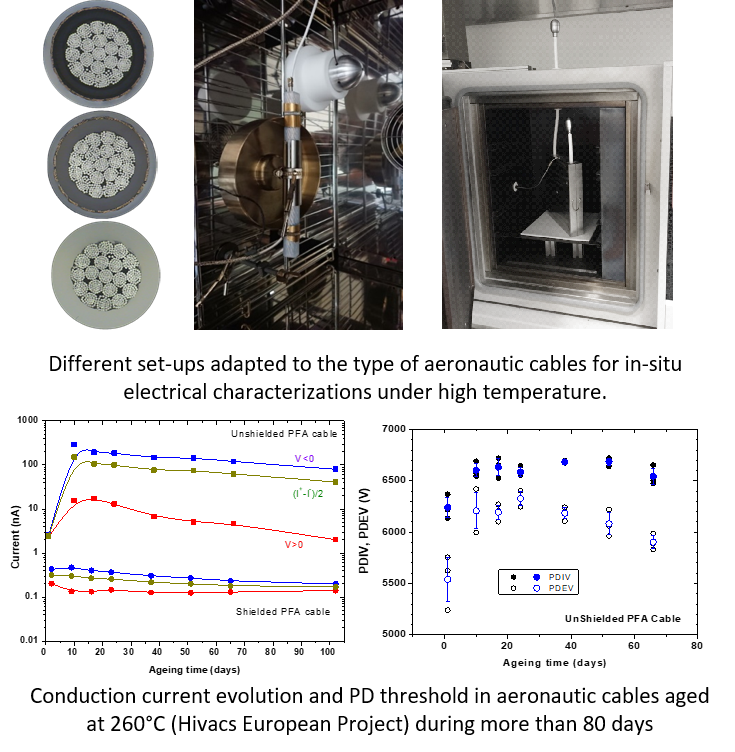
Ageing of aeronautic cables:
Thermal constraints and the control of risks associated with partial discharges in aeronautical cables are being studied jointly with the MDCE group. Several set-ups are available or under development to reproduce high temperatures and depressurisation. The aim is to identify and distinguish between ageing that is intrinsic to the materials and ageing due to the cable geometry and fittings (delamination, shrinkage, etc.).
For example, ageing under prolonged thermal stress (260°C) (several months) has been carried out with in-situ partial discharge and conduction current measurements, coupled to physicochemical diagnostics.
Anomalies in the current transients were revealed in the PFA above 200°C, possibly resulting from ion electromigration or material degradation.
Toward self-healing materials?
In our research activities, the objective is mainly focused on improving the electrical and thermal performance of materials, through new formulations, doping, purification or association with inorganic reinforcements, as an example.
Other concerns are emerging, such as the recyclability or the bio-sourcing of materials, which mean that we need to calibrate their properties against the state of the art.
On a more futuristic note, the idea of producing materials that are not just durable, but also have the ability to regenerate, has been around for a decade with vitrimers, materials that undergo permanent reorganisation above a certain temperature. We are exploring these materials, in collaboration with the MDCE team, with a first family focusing on trans-esterification exchanges. The broadband dielectric properties of such materials, which have been proven to be self-healing, are being explored in relation to their formulation.
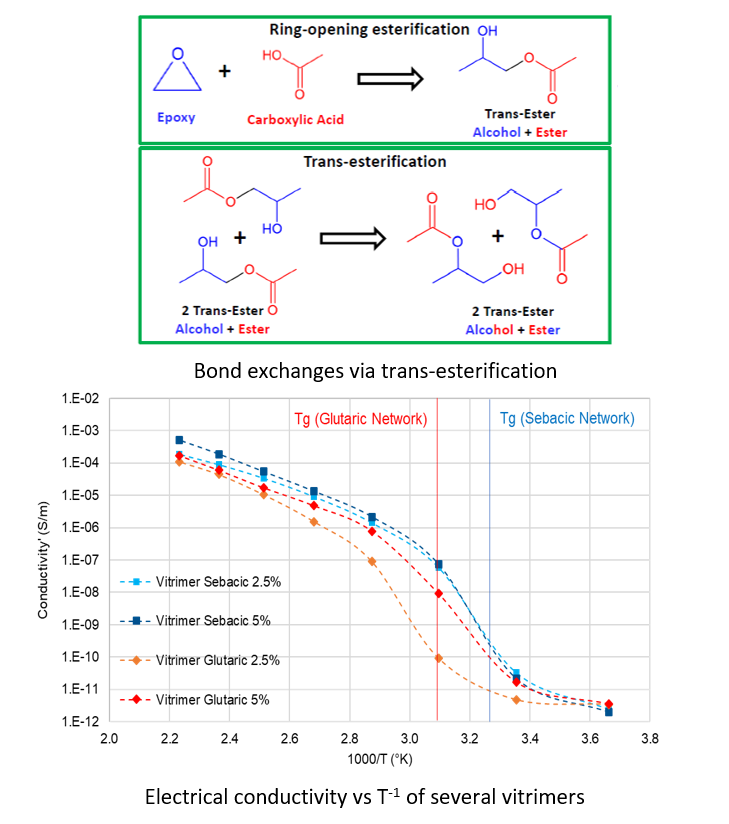
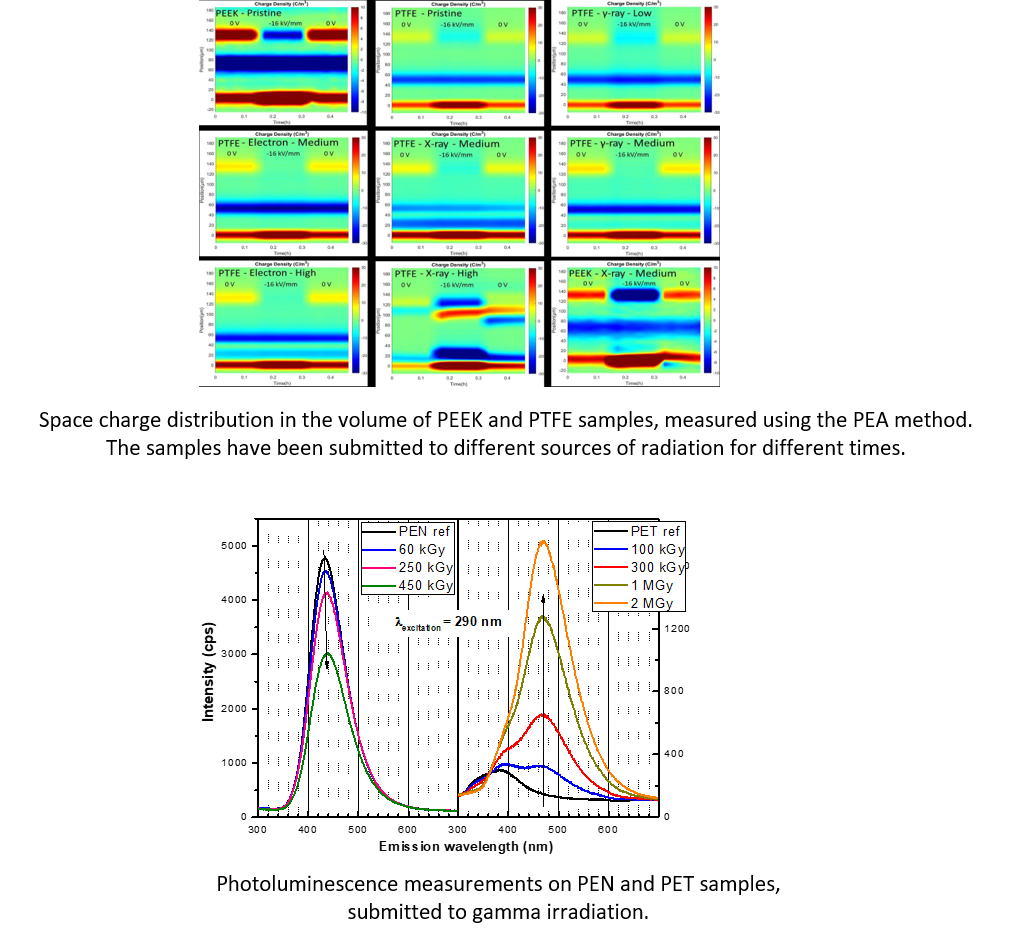
Materials characterization under charging environment:
Insulating materials used in the space environment or in nuclear power stations are subjected to various types of radiation that can contribute to their long-term degradation. For dielectrics selected for their electrical insulating properties, it is necessary to determine the effect of this radiation on their properties over time. To do this, it is necessary to expose the materials to various sources (electron beam, gamma radiation, X-rays, etc.) and to assess the effect of the dose on the dielectric properties. International collaborations have been set up to achieve this, as access to radiation sources remains complex. The characterization tools we have developed in the laboratory enable us to highlight changes of the material behaviour over time, the aim being to correlate structural modifications and the electrical properties of the studied insulations. In particular, we are trying to study the space charge distribution using an in-situ PEA method. We also use electron charge implantation by electron bombardment to inject negative charges without contact and monitor their behaviour in the volume of the samples.We also carried out conductivity and luminescence measurements, coupled to physico-chemical characterizations.
Objectives:
Study the multi-scale electrical properties (transport, trapping, charge emission…) of nano-structured dielectric materials and their interfaces.
One of the challenges is to develop methodologies for determining electrical properties at the nanometric scale. This involves coupling modes derived from AFM and finite element modelling. It is thus possible to measure :
– the dielectric permittivity using Electrostatic Force Microscopy (EFM),
– the charge transport behaviour using Conductive AFM (C-AFM)
– the charge density using Kelvin Probe Microscopy (KPFM).
– the mechanical properties using Nanomechanical Mode (PF-QNM).
The second challenge concerns the multi-scale approach and the comparison of electrical properties obtained at different scales. This will improve our understanding of the physical phenomena governing the transport and trapping of charges in inorganic and organic materials deposited in nanostructured or non-nanostructured thin films.
Our interest focuses on the study of the properties of thin film materials, nanocomposites and interface/interphase zones.
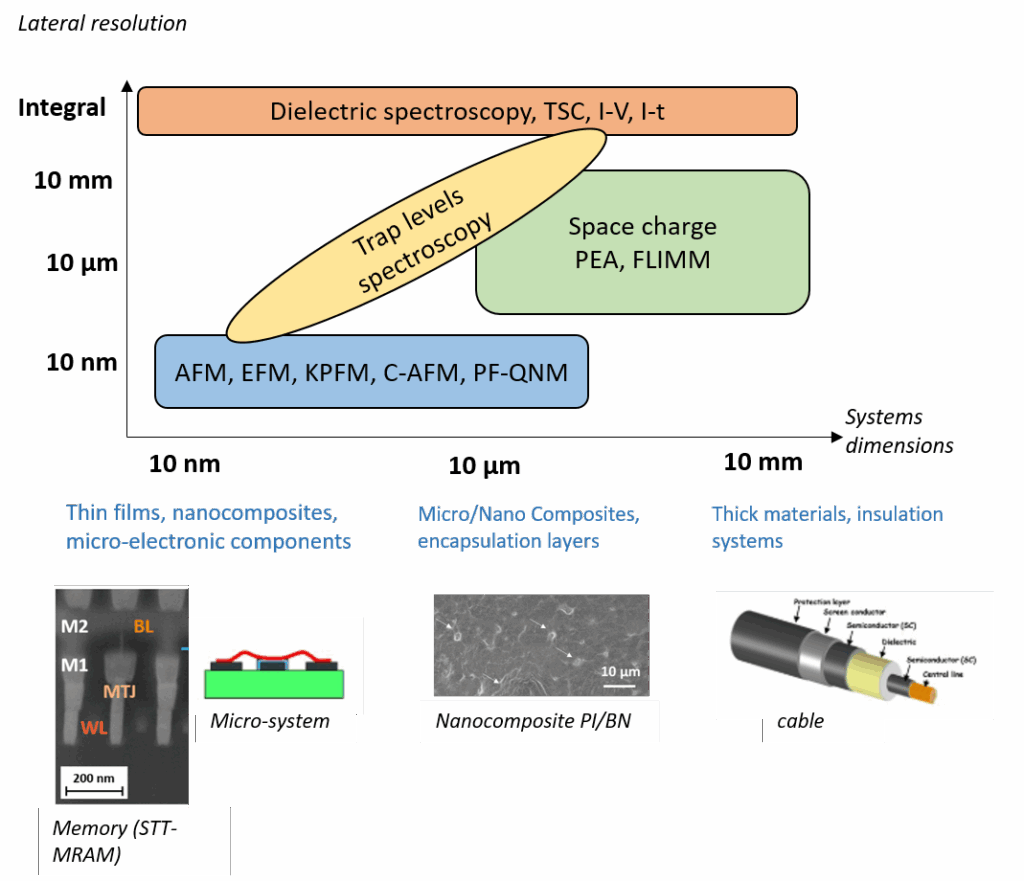

physical phenomena at a metal/dielectric interface:
The interfaces properties (structural or chemical defects, contact charges, etc.) have a major impact on the physical mechanisms behind the charges injection and transport. However, the understanding of the physical phenomena at play at this scale is still scarce, as these properties are often studied on a macroscopic scale.
To characterize the properties of metal/dielectric interfaces at a nanometric scale, we have developed a methodology based on techniques derived from AFM. To do this, metal/insulator/metal (MIM) multilayers are studied on the wafer (Figure a), in order to determine :
– The localisation of the interface and its roughness (measured using the topography mode (figure b) or the nanomechanical mode)
– The surface potential is measured in KPFM mode (figure c), and the charge density at the interface (red arrows on Figure d) is deduced using Poisson equation.
Study of inorganic nanocomposites for micro-electronic applications:
Improving the dielectric materials performance in the area of microelectronics applications, and more specifically for metal-insulator-metal (MIM) capacitors, requires the development of new 2D or 3D nano-structured materials. The main challenge lies in increasing the dielectric permittivity and the breakdown field, while maintaining a low leakage current. In this context, nano-structured thin films (nanocomposites, multilayers, etc.) need to be designed. One possible approach is to use plasma to produce SiO2 and TiO2-based nano-materials fulfilling the desired properties as regards permittivity and low leakage currents. Characterization methods at this scale need to be develop, to understand the mechanisms linked to the improvement in electrical properties.
Electrical modes derived from atomic force microscopy (AFM) are perfectly suited. Coupled with finite element modelling, they provide access to a number of electrical quantities such as current measurement by Conductive AFM (C-AFM), measurement of permittivity by Electrostatic Force Microscopy (EFM) or charge density derived from Kelvin Probe Microscopy (KPFM).
These studies are being carried out as part of the ANR ADN project in collaboration with the ScIPRA team at Laplace and IMN in Nantes.
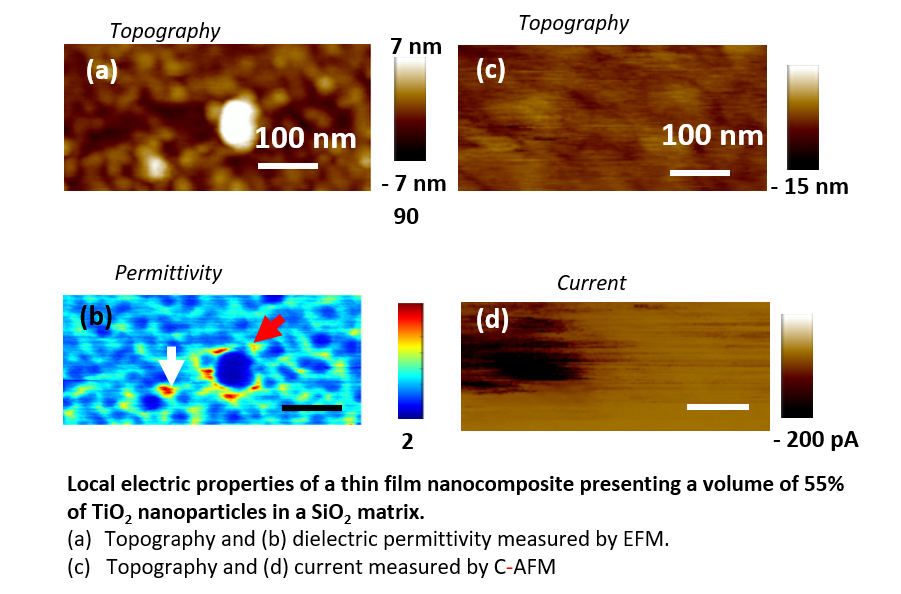
Experimental means :
Moyens numériques :
* access via Laplace plateforms :
| NOM Prénom | Corps / Tutelle | Page Personnelle |
|---|---|---|
| {{statut.name}} | ||
| {{ item.nomprenom }} {{ item.nomprenom }} ({{item.servicecommun1}}) | {{ item.corps }} / {{ item.tutelle }} {{item.statut.toUpperCase()}} | Page web |

Baptiste Robbiani soutiendra sa thèse le mardi 16 décembre 2025 à 09h45 – amphi Concorde U4 à l’UT, sur le sujet : « Analyse de

Sariette NOWA soutiendra sa thèse le vendredi 26 septembre 2025 à 9h30, lieu de soutenance : 325-327 118 Rte de Narbonne, bat 3R1 B4 31400
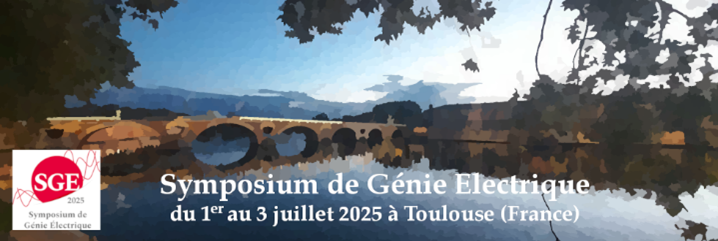
Le 6ème symposium de génie électrique, SGE2025, a eu lieu à Toulouse du 1er au 3 Juillet, au centre de congrès Pierre Baudis. Ce symposium,
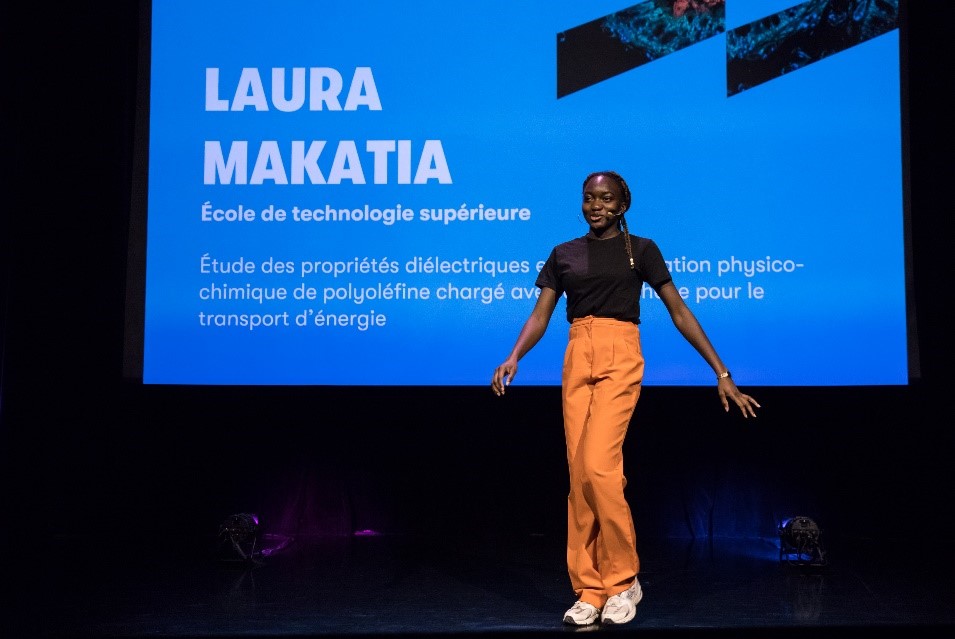
Laura Makatia : Lauréate de l’édition MT180 2025 de l’Ecole Supérieure de Technologie de Montréal

La soutenance de thèse d’Assane NDOUR intitulée : “Modélisation et caractérisation expérimentale du champ électrique et des charges dans un isolant de câbles HVDC de

La 5e International Conference in Dielectrics (ICD) s’est tenue à Toulouse du 30 juin au 5 juillet 2024 sur le site de l’Université Toulouse III

Après Oléron en 2019 et Cahors en 2022, la troisième édition de l’école thématique FiabSurf s’est tenue du 22 au 26 avril 2024 sur l’île
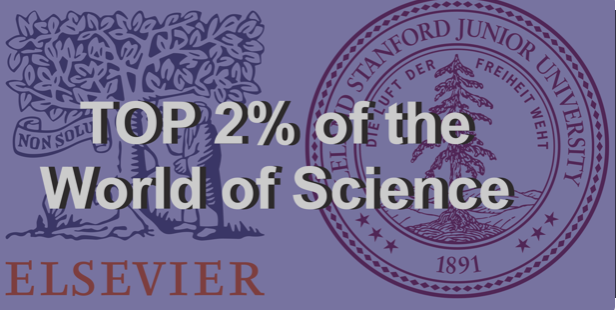
11 chercheurs et enseignant-chercheurs du LAPLACE référencés dans le “TOP 2% Scientists Worldwide” d’après l’étude Standford s’appuyant sur l’impact des travaux des

La soutenance de thèse de Duvan MENDOZA-LOPEZ , intitulée “Étude des phénomènes de piégeage et dépiégeage de charges par mesures de charge d’espace et de

La soutenance de thèse de Baptiste ARATI, intitulée “Manufacturing and characterization of self-healing polymers intended for the electrical insulation of future power modules”, aura lieu
